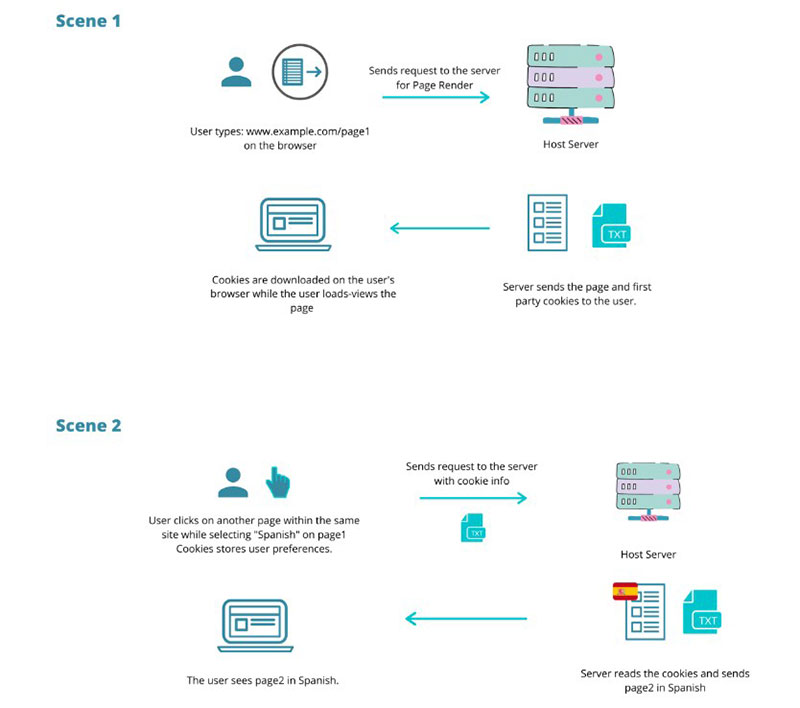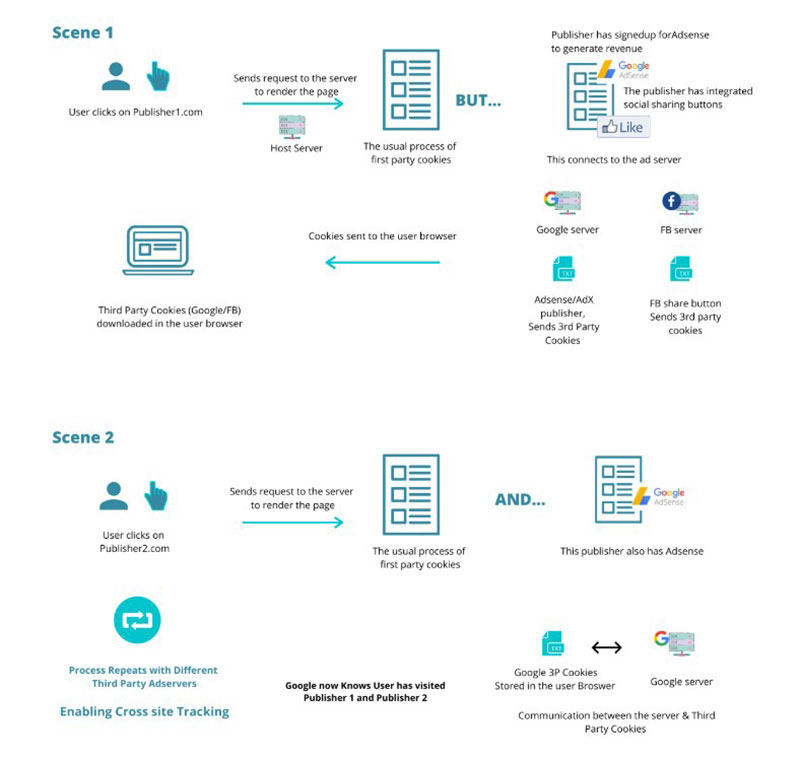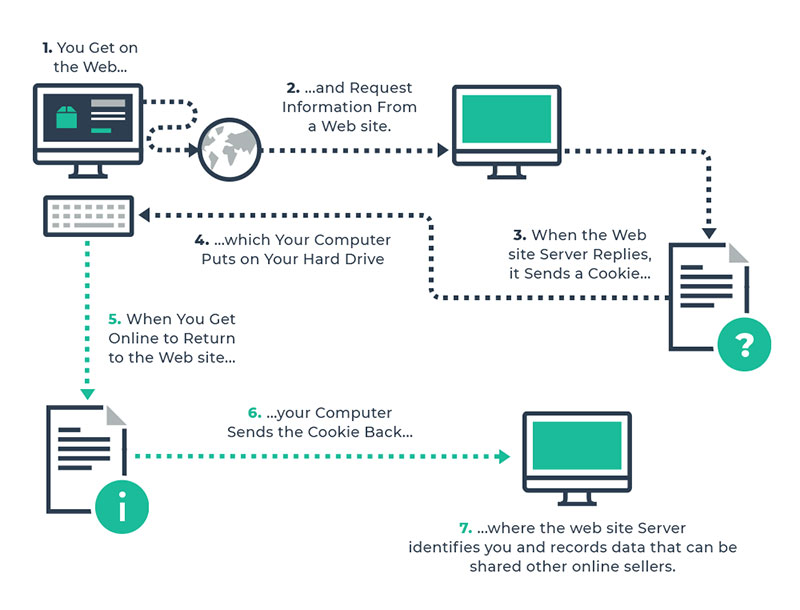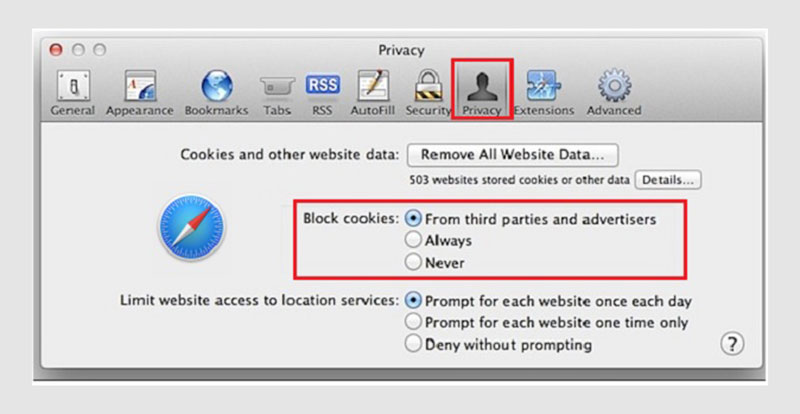Imagine a digital footprint, seemingly invisible, trailing you across the vastness of the internet. This footprint tells a tale, a narrative crafted by third-party cookies, those tiny data sentinels that hold the keys to our online behaviors. Within the ever-evolving web design landscape, these cookies—often vilified yet deeply ingrained—have become the silent puppeteers of personalized user experiences.
Within this cosmos of data collection and online privacy, tension thickens. Governmental privacy regulations tighten their grasp; browsers like Google Chrome and Mozilla Firefox hatch plans to limit the reach of browser tracking. A new dawn looms near, and the intoxicating dance between ad personalization and privacy rights gains fervor.
This article unfolds the fabric of third-party cookies: we’ll delve into their intricate role in advertising networks and user consent, scrutinize the impact of legislative behemoths like GDPR and CCPA, and examine strategies for visitor identification without infringing the sacred creed of privacy.
Step inside my digital atelier. Together, we will navigate the labyrinthine world of the third-party cookie, equipping you with the knowledge to make informed choices, ensuring your creations are both legally compliant and designed to honor user consent.
What Are Third-Party Cookies?
Third-party cookies are tracking codes placed on a website by someone other than the owner (typically advertisers), to collect user data across different sites. This helps advertisers create targeted ads by understanding user behavior, but has raised privacy concerns, leading to increased regulatory scrutiny.
First-Party Cookies

Image source: madmartech
First-party cookies are placed on the website by the owner. They collect first-party data and use it to remember website configuration like user settings and preferences. The data collected by first-party cookies are often part of a broader web analytics strategy.
They track and remember things like:
- language preferences
- login details
- products added to a shopping cart
- user preferences
- user settings
First-party cookies enable the owner of a website to provide a good user experience, even allowing for personalized settings based on user behavior.
For example, a customer browses an online store and places a product in the cart, then they opt-out and exit the site. When they return to the site, they see that the product is still in the cart thanks to cookie management.
They are experiencing the benefits of a first-party cookie.
Third-Party Cookies

Image source: madmartech
Third-party cookies, often set up by a third party through tags, are also called tracking cookies or targeting cookies. They’re placed on a website by someone other than the website owner, often for online advertising purposes.
These cookies track the same information as first-party cookies, sometimes more. All the tracked information, such as age and gender, goes to the third party, often for the purpose of creating user profiles.
But third-party cookies are not there to provide a good user experience. They are mostly used for advertising purposes, specifically for personalized ads based on user behavior.
Information that third-party cookies collect includes powerful information like:
- age
- gender
- user-behavior
Third-party cookie data identifies users online and reveals their likes and dislikes, which is useful in enhancing online marketing strategies.
Online advertising is the most common use of third-party cookies. It uses the data to create user profiles and then present personalized ads, impacting various facets of online marketing.
Third-parties can add cookies to a webpage through tags. These tags are sometimes connected to an advertisement but not always, and they play a vital role in behavioral advertising.
Differences Between a Third-Party Cookie and a First-Party Cookie in the Context of Web Activity and User Behavior
First-Party Cookie
Who sets it?
It is set by the owner of the website. It is supported by all browsers as part of general internet security measures.
What do they track?
They only track the user on the domain that created the cookie, primarily collecting first-party data.
What is their purpose?
Their purpose is to give users smoother site access and a good user experience. They remember login information, site preferences, language preferences, products added to a shopping cart, etc.
Can you disable first-party cookies?
Users can block and delete them through browser settings, but it may result in a bad user experience or affect the website configuration.
Third-Party Cookie
Who sets it?
A third-party cookie is set by a third-party server, often for digital advertising purposes. It is set by code loaded onto a publisher’s site from ad servers, social media sites, live popup chats, and more.
What do they track?
They track users across many domains, often part of broader web analytics or behavioral advertising efforts.
What is their purpose?
Their primary purpose is to enable adware and data collection platforms to retarget potential customers with personalized ads as they move from site to site, based on their online behavior.
Can you disable third-party cookies?
Many browsers are now blocking third-party cookies by default as part of enhanced privacy policies. Users can also delete and block them on a regular basis from the browser settings to avoid tracking and minimize temporary storage on the device.
From any browser window, go to settings and click on the privacy or security option. Users can also opt-out and use private or incognito mode to block cookies during a browsing session.
What Are Third-Party Cookies Used For in Online Advertising?
Advertisers and online marketing agencies use third-party cookies to learn about users’ browsing habits and online behavior.
They collect data about which websites users visit often, thereby forming user profiles. They record what purchases have been made and what products have shown an interest in.
For example, users go to a website. They show interest in a product by clicking on it and reading the specifications.
They exit the site and go to another site that may be completely unrelated to the initial product. The current website, thanks to behavioral advertising and tracking cookies, shows advertisements for the product they showed interest in.
This is the result of third-party cookies in action.
Examples of Third-Party Cookie Use and their Impact on Behavioral Advertising
The most common third-party entities are social media sites, advertisers, and marketers.
Here are some examples of how third-party cookies work:
- A customer goes to bestbuy.com and looks at a product. A third-party cookie tracks, collects, and analyzes their activity on that website as part of a broader online marketing strategy.
They leave bestbuy.com and go to a completely different website. On the second website, they see advertisements for the product or similar products to the one on BestBuy, thanks to cookie management and targeted advertising.
This means that both BestBuy and the second website load a piece of code from an ad server. The code from the ad server is from a different domain, making the cookies third-party cookies, and thereby a part of behavioral advertising efforts.
- An advertising service (for example, Google Ads) creates a third-party cookie for targeted advertising. This allows them to monitor which sites a user visits and then shows personalized ads based on the collected data.
- You visit a website that has a Facebook “Like” button. Although you don’t click it, it contains a third-party cookie that stores information.
That information helps identify different users and tracks which websites they go to. Then if they go to Facebook, the user will see personalized advertisements as part of a broader online marketing effort.
How Are Third-Party Cookies Created in the Context of Web Activity and User Behavior?

Third-party cookies are created as part of online advertising methods when a request is sent from the web page to the third party’s server for data collection. The requested file may be an actual advertisement or it can be a file with a tracking pixel for web analytics.
A tracking pixel is invisible to the user but collects data even when there are no click events, as part of broader online marketing strategies.
One basic way a third-party cookie is created is when a website requests a third-party service for digital advertising purposes. One example is an integrated live chat pop-up to enhance user experience.
For live chat to work, websites request a script from a service provider as part of their website configuration. The script loads the live chat file.
The user’s web browser receives the file with the live chat and some third-party cookies. Before the user notices, these cookies for behavioral advertising start collecting information about them.
Any request from a third-party domain can put cookies in web browsers as part of internet security measures. It can be from a script, image, fonts, CSS files, etc.
As the web page loads to retrieve the data, it assigns a cookie to the user at the same time, thereby affecting the user’s online behavior.
Examples of Third-Party Services That Leave Cookies as Part of User Profiling
Several third-party services leave cookies in web browsers. Here are a few examples of the main services that do so:
Ad Retargeting Services
Ad retargeting means following previous visitors to websites around the web as part of a cookie management strategy. They show advertisements for products that the visitor has shown interest in or has interacted with previously.
Retargeting efforts work across social media platforms, email, and more as part of a broader online marketing effort.
Website owners place an invisible tracking pixel on their site. When their site loads, it sends a request to the ad-retargeting server.
The ad-retargeting server then assigns a cookie to the user for targeted advertising. Then it can track the user and retarget them on other websites.
Social Buttons

Social media buttons allow users to log in, share, or like social media content as part of their online behavior. These buttons place cookies on the user’s device.
The social media platforms then track the user for targeted advertising. They also collect information about their online behavior for user profiling.
When users open a social media platform, they see ads based on the data collected, thereby enhancing their personalized online experience.
Live Chat Pop-Ups
As discussed above, live chat pop-ups also leave cookies in a user’s browser as part of enhancing user experience. These cookies help streamline the user experience for behavioral advertising.
For example, when a user visits the same chat box, it identifies the user through first-party data. It also remembers the conversation history, adding to their user comfort.
Are There Benefits to Third-Party Cookies in the Context of Digital Advertising?
Third-party cookies mostly benefit advertisers by enabling a wide range of online advertising methods. They allow advertisers to understand users better and know what interests them as part of user profiling.
Then they can display individualized ads based on first-party data. Some users prefer this.
Since they have to look at ads anyway, they prefer them to be relevant to their individual needs, thereby enjoying a personalized internet experience.
Users benefit more from first-party cookies. The first-party data collected from cookies is responsible for user comfort and an enhanced user experience.
They provide a better user experience and allow users to get results faster based on their online behavior.
The benefits of third-party cookies for advertisers, publishers, and users are as follows, enhancing both user experience and advertising revenue:
Benefits For Advertisers:
- Internet users see relevant ads, which motivate them to click on them. This generates more advertising revenue and enhances their online marketing strategies.
Benefits For Advertisement Publishers:
- Easy to implement because the work is done by the third-party server.
- Visitors see relevant ads which encourage them to click on them. This increases the revenue publishers get from ads, enhancing their cookie management strategy.
Benefits For Users:
- Personalized advertisements only show products users have an interest in, making the internet seem individualized.
- Website operators must be transparent about how they use third-party data for user profiling.
- Many web browsers allow users to block third-party cookies as part of enhanced privacy policies.
The End of Third-Party Cookies and Its Impact on Online Advertising and User Behavior

As noted, the phasing out of third-party cookies in the context of digital advertising has already begun, impacting both web activity and data collection methods. There are various reasons for this shift in the digital advertising landscape.
One reason is that advertisers and publishers have to combat ad blockers as part of their online marketing strategies. These tools and other methods disable cookies from tracking and collecting user data.
Another reason is the increase in mobile website browsing.
It is more difficult to track users across several devices, impacting behavioral advertising. This means that advertisers are receiving an incomplete picture of users.
A third, very compelling reason is the growing awareness of privacy issues associated with third-party data collection and user profiling. Many new regulations like the CCPA and GDPR are seeking to protect the personal data of website users.
Examples of new privacy regulations affecting internet security include:
- The California Consumer Privacy Act (CCPA)
- The General Data Protection Regulation (GDPR) in the European Union
These regulations change how advertisers and marketers manage, trade, and use consumer data as part of their cookie management strategies. Civil and criminal penalties loom large if websites are not transparent. It’s recommended to consult qualified criminal lawyers for advice on compliance.
They must notify users of the presence of cookies, the data they collect, and who they share the data with. Users must also have a way to opt out of cookie data collection as part of enhanced privacy policies.
The upcoming ePrivacy Regulation will likely put more restrictions on the use of third-party cookies in web browsers. Thus, their utility in their current form for advertisers and user profiling is limited.
Mozilla’s Firefox and Apple’s Safari now block third-party cookies by default as part of internet security measures. Google announced that Chrome will follow suit in 2022, affecting its advertising revenue.
This may be due to the fact that 90% of Google’s revenue comes from advertising. Without the information from third-party cookies, their revenue from targeted advertising could be adversely impacted.
Until then, Google is taking steps to reduce the invasive aspects of third-party cookies to consumer privacy.
Is the Future of Online Advertising Doomed?
For users surfing the web, the end of third-party cookies might signal an end to personalized ads and user comfort.
But for advertisers and publishers, the effect will be much greater due to volatility in the digital advertising industry.
Publishers will face a reduction in advertising revenue.
Advertisers will lose the accuracy in targeted advertising. Thus, the price per view may decrease, affecting the revenue of publishers as well.
Many wonder if the future of online advertising is doomed. The answer is no.
Money will find a way, and advertisers will discover several alternatives to third-party cookie data collection, affecting their online marketing strategies.
Digital advertising will undergo big changes, but both publishers and advertisers will adapt and new solutions will emerge.
Publishers could create their own ad solutions based on first-party data received from customers for more accurate user profiling.
Advertisers and publishers may need to collaborate more closely. This will allow them to produce targeted ad campaigns based on enriched data.
Relying More on First-Party Data for Enhanced User Experience
With third-party cookies gone, the data from first-party cookies will become more valuable. First-party data collects valuable information such as email addresses and previous purchases for user profiling.
Brands will need to find ways to collect first-person data directly from users. This information will enrich the data collected on them and boost marketing campaigns as part of a comprehensive online marketing strategy.
Some ways to collect first-person data for a personalized internet experience include:
- Email login before sharing free content
- Direct contact through email or text messaging
- Guided selling experiences that ask for customer input
- Post-purchase and customer surveys
Shift to Contextual Advertising and the Role of Content Marketing in the Digital Advertising Landscape
Contextual Advertising displays ads on websites based on the content of the site, making it a form of targeted advertising. It allows advertisers to show Pay-Per-Click ads on web pages that rank for similar keywords as theirs, part of modern web activity.
For example, if an ad is for car equipment, it will appear on websites featuring car equipment content, following user profiling algorithms.
People-Based Targeting and its Contribution to Behavioral Advertising

People-based targeting tracks online user behavior across devices as part of behavioral advertising. It channels but does not store any information that could identify the user, thus maintaining some level of internet security.
Previously, people-based targeting was most effective within specific platforms like Facebook, where users are more willing to provide personal information as part of their user comfort.
Nowadays, using people-based targeting methods allows marketers to gain deeper person insights for better user profiling.
One suggestion is to combine this method with automation. This makes it possible to deliver personalized, relevant, and tailored ads to users, enhancing their overall internet experience.
Effects of the Elimination of Third-Party Cookies and Strategies for Internet Security
The elimination of third-party cookies will significantly affect the digital advertising industry and will also shift how the internet is used, impacting internet security measures.
Users might receive fewer targeted advertisements, which some may see as an agreeable compromise for the sake of personal information privacy.
Publishers could face a decrease in advertising revenue as advertisers will pay less for less effective targeted ad campaigns.
Advertisers who have relied on personal information for highly targeted ad campaigns will need to adapt to the landscape changes in digital advertising.
Alternative methods like first-party cookies, contextual advertising, and people-based targeting provide avenues for marketers to continue effective campaigns while respecting privacy rights.
Marketers should implement these advertising strategies now to remain agile. As further changes emerge, they can adapt without falling behind in the evolving digital advertising landscape.
It’s crucial to stay up-to-date with new developments affecting third-party cookies and cookie management strategies, ensuring that any new policies will not negatively impact their business.
FAQs about What Third-Party Cookies
How Do Third-Party Cookies Affect Online Privacy?
At their core, these cookies paint a vivid digital portrait of users. As they traverse various websites, the connective thread of cross-site tracking gathers intel, raising flags around online privacy. They stir the pot of the privacy-conscious, brewing a concoction that sometimes tastes a bit too intimate.
Are Third-Party Cookies Dangerous?
Danger is an overstatement, but they toe a delicate line. They nudge into personal space by sketching your interests, hobbies, and occasionally, more private data. While not malicious on their own, in the world of data protection and breaches, they could potentially be a privacy protection Achilles’ heel.
Can I Block Third-Party Cookies?
Absolutely. Browsers like Firefox and Google Chrome have baked in settings that banish these cookies to the void. Tweak your browser settings, often found under privacy or security tabs, and voilà – you’ve built a digital moat against the siege of these ubiquitous trackers.
How Will Blocking Third-Party Cookies Impact My Browsing?
Curtains down, tracking eases. You might notice ads losing their personal touch, morphing into generic billboards. However, it’s a small trade-off to intercept the barrage of behaviorally targeted campaigns. Some website functionalities that rely on such cookies could give you the cold shoulder, though.
What is the Difference Between First-Party and Third-Party Cookies?
First-party cookies are the residence’s mainstay; they remember your preferences like a considerate host, enhancing your on-site experience. Third-party cookies, however, are akin to visitors roving from one site to another, pocketing notes about your digital itinerary, using them to later retarget ads to you.
Will Third-Party Cookies Go Extinct?
The digital winds whisper of an impending ice age for these cookies. Browsers are slamming gates, and privacy regulations are tightening the noose, with the ad tech industry veering towards more privacy-compliant alternatives to uphold user trust.
How Do Advertisers Track Without Third-Party Cookies?
Clever minds devise alternatives — think first-party data, employing contextual advertising, nudging cookie consent banners to seek permission for tracking, and exploring tracking prevention technologies like fingerprinting, which, mind you, brew their own privacy controversies.
Does Europe’s GDPR Affect Third-Party Cookies?
GDPR is the knight in shining armor for personal data. It demands explicit user consent before any cookies can be dropped and chomped on, turning the table on how ad marketers must seek user consent before unleashing their tracking pixels into the wild.
With Third-Party Cookies Phasing Out, What’s Next in Online Advertising?
The crystal ball shows no apocalyptic scene, but a renaissance. Ad personalization isn’t dying; it’s merely shapeshifting. We’ll witness more reliance on machine learning-driven ad retargeting, secure cookie attributes, and perhaps a nirvana where user experience and privacy coexist. Trust in the adaptability of digital marketing tactics — for they are many and mighty.
Conclusion
As the curtain falls on our expedition through the intricate web of third-party cookies, the horizon of digital interaction stretches before us, revealing landscapes reshaped by a collective yearning for online privacy and transparent data collection. The future holds a bastion where ad personalization no longer hinges on unseen observers but flourishes through ingenious, consent-based methodologies.
In a realm where browser tracking is restrained, we’re witnesses to a paradigm shift. Creatives and strategists join forces, forecasting a reinvigorated era of digital marketing tactics that honor the individual’s sovereignty over their digital shadow.
The takeaway? Embrace the change. As these miniature data sentinels retreat into the annals of the internet’s evolution, the opportunity to innovate beckons. With every ad tech industry pivot, comes a clarion call to realign, adapt, and craft user experiences that resonate on a personal level, sans the invasive overtures of the past.
Let’s sculpt a future that marries user consent with the uninhibited joy of discovery that the web was always meant to offer.
If you enjoyed reading this article about what are third-party cookies, you should check out this one about what is AdTech.
We also wrote about a few related subjects like MVP tests, personalization algorithms, how to hire a web development team, software development budget, financial projections for startups, financial software development companies, proof of concept vs prototype, and behavioral targeting.
- What Are Third-Party Cookies and How They Work - April 20, 2024
- How Do Websites Detect Adblock? It’s Quite Simple, Actually - April 14, 2024
- Financial Software Development Companies You Should Know - April 11, 2024









